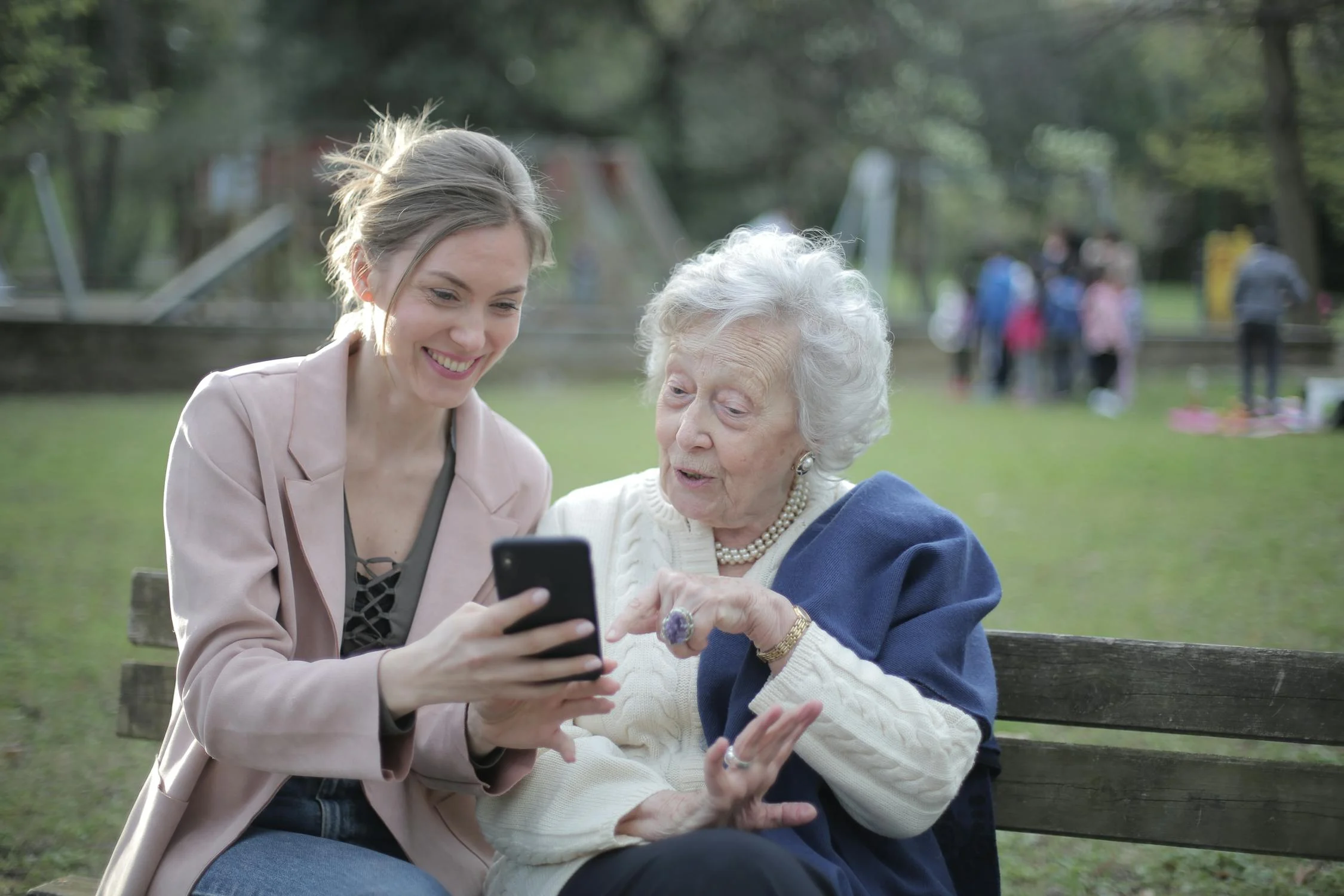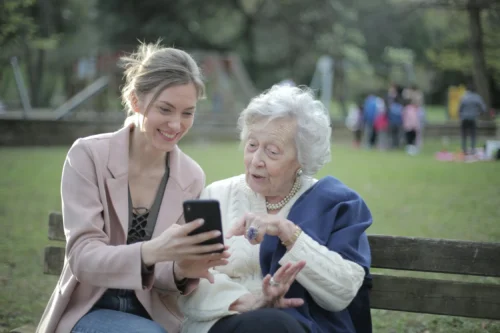
28 Aug How Technology Can Enhance Senior Health and Well-Being

Photo by Andrea Piacquadio
As we continue to live in a world where technology is advancing day by day, its impact on various aspects of our lives grows ever more significant.
One area where technology is making a profound difference is in the health and well-being of seniors, with innovations such as telemedicine Colorado offering accessible healthcare solutions.
As much as we believe that the elderly are so far untouched, the new age interactive use of technology has not only brought seniors close to use of gadgets, but interestingly they are engaging and entertaining.
By adopting various digital tools and platforms, seniors can maintain their independence, stay connected with loved ones, and manage their physical and mental health more effectively.
This article explores how seniors can use technology to enhance their health and well-being and provides practical tips on incorporating these innovations into their daily lives.
1. How to Use Health Monitoring Devices for Better Health Management
Wearable Health Devices:
- What They Are: Wearable health devices, such as smartwatches and fitness trackers, are designed to monitor vital signs like heart rate, blood pressure, and oxygen levels.
- How They Help: Seniors can wear these devices throughout the day to track their health metrics continuously. Features like fall detection and emergency alerts are particularly useful for seniors living alone, as they provide a quick way to call for help in case of an emergency.
- Getting Started: To use a wearable health device, seniors simply need to wear it on their wrist or clip it onto their clothing. Most devices come with companion apps that provide detailed health insights and alerts, making it easy for seniors to monitor their health.
Telehealth Services:
- What They Are: What They Are: Telehealth services allow seniors to consult with healthcare providers such as Proactive care remotely via video calls, phone calls, or online chat.
- How They Help: Telehealth makes healthcare more accessible by eliminating the need for travel, especially beneficial for seniors with mobility issues or those living in remote areas. It allows seniors to receive medical advice, manage chronic conditions, and refill prescriptions from the comfort of their homes.
- Getting Started: Seniors can access telehealth services through their healthcare provider’s website or app. They need an internet connection and a device such as a smartphone, tablet, or computer to participate in virtual consultations.
Medication Management Apps:
- What They Are: Apps such as MedManage, CareClinic, Pillboxie, etc provide reminders and alerts for taking medications and can track medication schedules and doses.
- How They Help: Medication management apps help seniors adhere to their prescribed regimens, reducing the risk of missed doses or incorrect usage. Some apps also provide information on potential drug interactions and side effects
- Getting Started: Seniors can download a medication management app from the app store on their smartphone or tablet. After entering their medication details, the app will send alerts when it’s time to take their medicine.
2. How to Enhance Mobility and Independence with Technology
Smart Home Devices:
- What They Are: Smart home devices include voice-activated assistants like Amazon Alexa or Google Home that can control lights, thermostats, and other home systems.
- How They Help: These devices enable seniors to perform daily tasks with ease, such as turning lights on or off, adjusting the thermostat, setting reminders, or even making grocery lists—all through simple voice commands.
- Getting Started: To set up a smart home device, seniors need to connect the device to their Wi-Fi network and use a smartphone or tablet to configure settings. Voice commands can then be used to operate the device and perform various tasks.
Mobility Aids with Technology Integration:
- What They Are: Modern mobility aids, such as walkers and wheelchairs, often come with built-in technology like GPS tracking, emergency buttons, and even voice-activated controls.
- How They Help: These aids provide enhanced mobility and safety, allowing seniors to maintain their independence while ensuring that help is always accessible in case of an emergency.
- Getting Started: Seniors can use these aids just like traditional mobility devices, with the added benefit of integrated technology. For example, they can activate emergency features by pressing a button or using a voice command, providing peace of mind for both the user and their loved ones.
3. How to Stay Socially Connected and Mentally Engaged with Technology
Social Media and Communication Platforms:
- What They Are: Platforms like Facebook, WhatsApp, Zoom, and simple universal tv remote for seniors enable seniors to stay connected with family and friends through messaging, video calls, and social sharing.
- How They Help: Staying socially connected is vital for seniors’ mental health and well-being. These platforms allow seniors to participate in virtual gatherings, share life updates, and maintain relationships, reducing feelings of isolation and loneliness.
- Getting Started: Seniors can create accounts on these platforms using their email addresses or phone numbers. Once set up, they can add contacts and start messaging or calling their loved ones. Most platforms also offer tutorials and help centers to guide new users through the setup process.
Online Learning and Cognitive Stimulation:
- What They Are: Online learning platforms offer a variety of courses and activities that seniors can engage in to keep their minds active. These include language learning apps, brain-training games, and courses on subjects ranging from history to science.
- How They Help: Continued learning and mental stimulation are crucial for cognitive health. By engaging in online courses and activities, seniors can exercise their brains, learn new skills, and stay mentally sharp.
- Getting Started: Seniors can explore online learning platforms like Coursera, Duolingo, or Lumosity. Many of these platforms offer free or low-cost courses and games that can be accessed on a smartphone, tablet, or computer.
4. How to Ensure Safety and Security with Technology
Personal Safety Devices:
- What They Are: Personal safety devices include GPS trackers, wearable alarms, and emergency call buttons that provide an extra layer of security for seniors, especially those with cognitive impairments or mobility challenges.
- How They Help: These devices can alert caregivers or family members if a senior wanders outside a designated area or needs immediate assistance, ensuring their safety.
- Getting Started: Personal safety devices can be worn like a pendant or a wristband. They usually come with instructions for setup and can be linked to a smartphone app that allows caregivers to monitor the wearer’s location and status.
Home Security Systems:
- What They Are: Smart security systems with cameras, motion sensors, and alarms can help seniors feel secure in their homes.
- How They Help: These systems provide peace of mind by monitoring the home environment and alerting the user or their family members of any unusual activity.
- Getting Started: To install a home security system, seniors or their caregivers can work with a professional installer or opt for DIY systems that come with easy-to-follow instructions. Most systems can be monitored remotely through a smartphone app.
Conclusion:
Technology has opened up new possibilities for seniors to enhance their health and well-being, offering tools that promote independence, safety, and social engagement.
By including these innovations for use, seniors can enjoy a better quality of life, maintain their health, and stay connected with the world around them.
Editor’s note: Online Games such as Connect 4 Online can be found Here.
As technology continues to evolve, its role in supporting senior well-being will only become more significant, providing even more opportunities for seniors to thrive in the digital age.
The information on MedicalResearch.com is provided for educational purposes only, and is in no way intended to diagnose, cure, or treat any medical or other condition.
Some links may be sponsored. Products, included compounded prescriptions above, are not warranted or endorsed.
Always seek the advice of your physician or other qualified health and ask your doctor any questions you may have regarding a medical condition. In addition to all other limitations and disclaimers in this agreement, service provider and its third party providers disclaim any liability or loss in connection with the content provided on this website.
Last Updated on October 24, 2024 by Marie Benz MD FAAD
